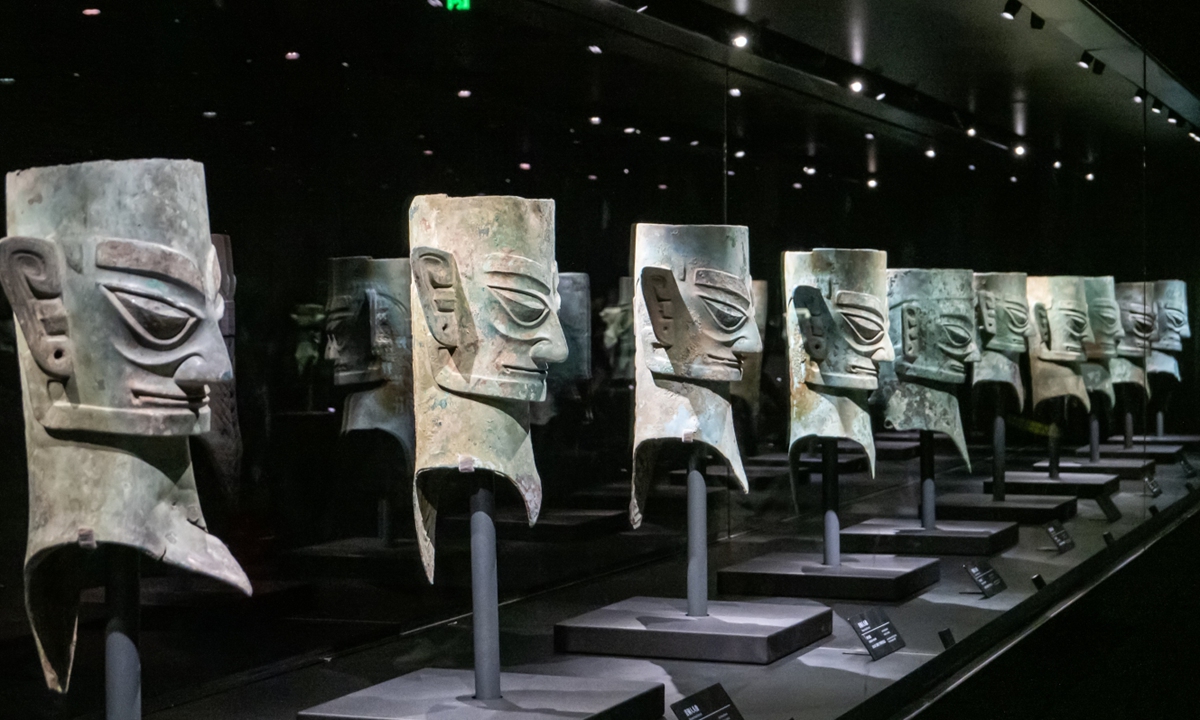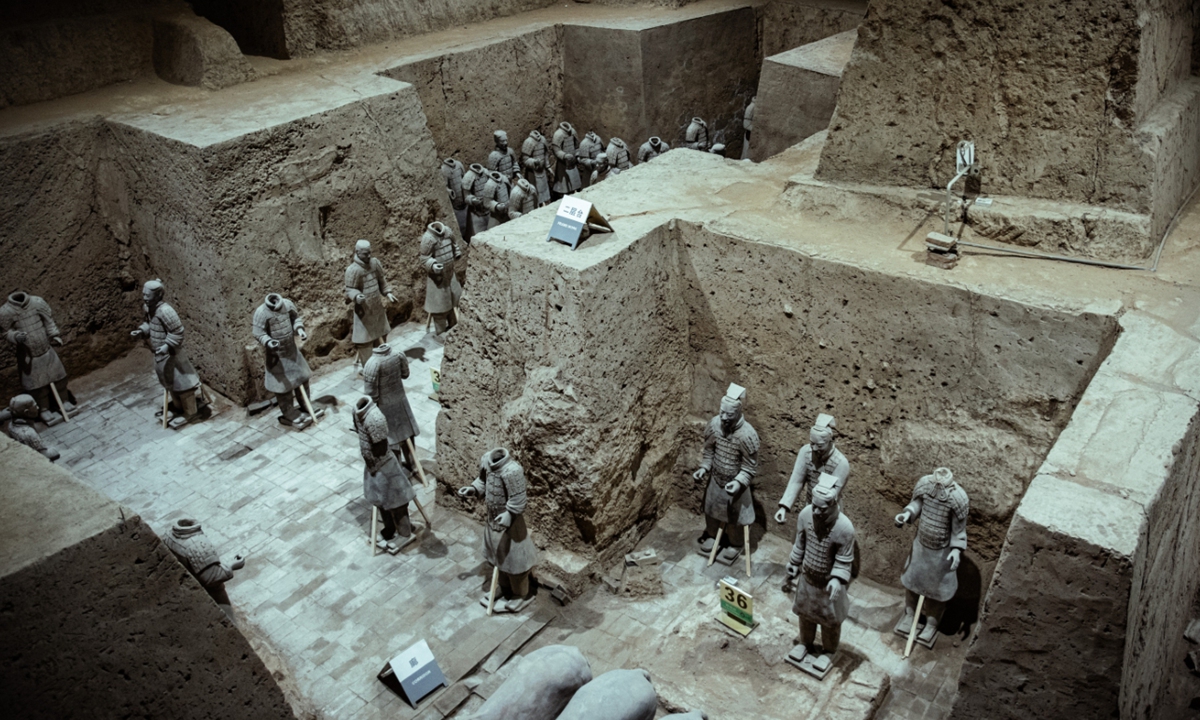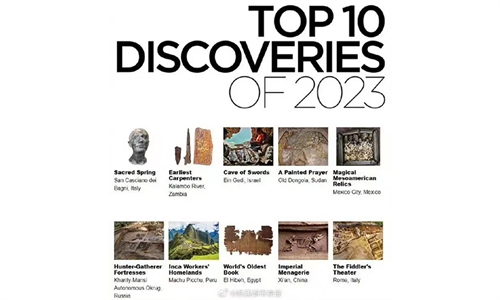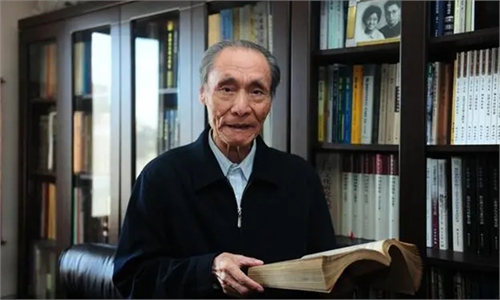
Bronze head sculptures on display at the new Sanxingdui Museum building in Guanghan, Southwest China's Sichuan Province Photo: VCG
Terracotta Warriors at Emperor Qinshihuang's Mausoleum Site Museum Photo: VCG
Editor's Note:
In 2023, a series of noteworthy topics have emerged in the Chinese cultural landscape, ranging from international cultural exchange to local creativity contributing to the development of Guochao, or China Chic. This also includes a flourishing domestic film market and literature scene, the rise of modern lifestyles among the youth, a surge in cultural tourism, as well as overall enthusiasm injected by international sporting events nationwide. Each of these reflects the pulse of the times.
In the planning of the 2023 Cultural Gala, the Global Times will delve into nine important topics, presenting a timeless and global cultural journey in nine segments, aiming to showcase the multidimensional aspects of Chinese civilization and the diverse charms of Chinese culture.
This is the second installment of the Global Times' Year-end Special on Culture, in which we review how the national project of tracing the origins of Chinese civilization has unveiled the mysterious history of China and highlighted the significant archaeological discoveries of the year, as well as the overall improvement of Chinese archaeology.
China's profound history is still a mystery to the world. To provide a clear timeline and restore the original face of Chinese civilization, the mega project of tracing the origins of Chinese civilization was proposed and entered its fifth phase in 2020. By expanding its research scope to 29 core sites, the project has achieved fruitful results, deepening the understanding of the origins and nascent stages of Chinese civilization.
According to China's National Cultural Heritage Administration (NCHA), the project suggests that approximately 5,800 years ago, distinct social differentiation emerged across various regions in China, marking the accelerated phase of Chinese civilization. This period, from 5,800 to 3,500 years ago, has been identified as the ancient state era and the era of dynasties.
The first stage of the ancient state era, around 5,800-5,200 years ago, is exemplified by the Niuheliang site in Northeast China's Liaoning Province, the largest known sacrificial site and tomb cluster in Northeast China's Hongshan culture.
The second stage, mapped to approximately 5,200-4,300 years ago, which includes the well-known Liangzhu site in East China's Zhejiang Province, witnessed increased social differentiation and enhanced mobilization of social resources.
The third stage, around 4,300-3,800 years ago, established a historical trend centered around the Central Plains, laying the foundation for China's historical development.
Researchers believe that 3,800 years ago, China entered the era of dynasties.
Wang Wei, director of the Academic Division of History under the Chinese Academy of Social Sciences, who has undertaken the national project for decades, told the Global Times that the project still faces many preliminary challenges that need to be addressed in an in-depth manner. The research team plans to trace the temporal and spatial scope of this research from 5,500 to 8,000 years ago, up until around 2,800 years ago.
Approximately 8,000 years ago, both material and spiritual culture made remarkable progress, and society began to show signs of differentiation. "We believe that civilization began when societies began to divide. Originally, we thought that this divergence occurred about 6,000 years ago, and now it appears that it occurred about 8,000 years ago," Wang explained.
He further clarified that the origin of civilization and the formation of civilization are different stages. The origin of civilization is calculated from the beginning of the differentiation of society, which marks the beginning of the accumulation of the quantity of civilization factors, while the formation of civilization is marked by the establishment of an emperor state and can be seen as a qualitative change.

Significant breakthroughs
Through the support of such a mega project, archaeologists across the globe are engaged in a more systematic excavation of the core sites. Additionally, the NCHA revealed the country's Top 10 Archaeological Discoveries of 2022, recognizing the most significant archaeological findings made in China during that period.
The year 2023 has proven to be a fruitful one for Chinese archaeology, with numerous breakthroughs occurring at world-renowned archaeological sites.
In October, an array of ancient chariots, including a four-wheeled wooden chariot and a rare "six-sheep" carriage, were discovered near the mausoleum of China's first Emperor Qinshihuang, in the Qin Dynasty (221BC-206BC) in Northwest China's Shaanxi Province, providing fresh insights into early burial practices during that era.
At the recently concluded fifth Shanghai Archaeology Forum (SAF), the world-renowned Sanxingdui Ruins site in Guanghan, Southwest China's Sichuan Province, claimed the SAF Field Discovery Award.
Ran Honglin, a research fellow at the Sichuan Provincial Institute of Cultural Relics and Archaeology, who is in charge of the Sanxingdui Ruins site, told the Global Times that winning the honor was mainly due to the site's unprecedented archaeological findings.
Currently, Chinese archaeologists have a preliminarily understanding of the distribution and internal structure of the sacrificial area. Notable, among the findings of the year are six sacrificial pits containing over 17,000 cultural relics, including gold ware, bronze vessels, pottery, and jade artifacts.
According to Ran, the team plans to collate and publish archaeological excavation reports about the Sangxingdui Ruins site as part of the preparation of the world heritage application.
An international development
During year-round events related to Chinese archaeology, many experienced Chinese archaeologists told the Global Times that they are amazed at the interdisciplinary collaboration in sciences and humanities as well as the support of cutting-edge technology, both of which have greatly improved the efficiency and indeed injected new vitality into Chinese archaeology in the new era.
For example, with the use of remote sensing, C14 dating, and GIS analysis, about 20 ruins believed to have once been dams have been discovered at the Liangzhu Ruins in East China's Zhejiang Province. This discovery has advanced China's archaeological research in water conservancy systems, Wang Ningyuan, a research fellow at the Zhejiang Provincial Institute of Cultural Relics and Archaeology, told the Global Times.
In addition, two shipwrecks were discovered at a depth of about 1,500 meters using the submersible Shenhai Yongshi, or Deep Sea Warrior, in October 2022, breaking the record in Chinese deep-sea archaeology, NCHA announced in May.
The productivity witnessed in Chinese archaeology has also attracted international attention from peers, with more achievements gaining acknowledgement from the world archaeology academia. The mysterious tomb of Emperor Wen, the third emperor of the Western Han Dynasty (206BC-AD25), for instance, was listed among the top 10 discoveries of 2023 by Archaeology Magazine.
During the fifth SAF, Chinese archaeologist Yan Wenming, a distinguished professor at Peking University, was honored with a Lifetime Achievement Award. This marks the first time a Chinese scholar has received such recognition.




